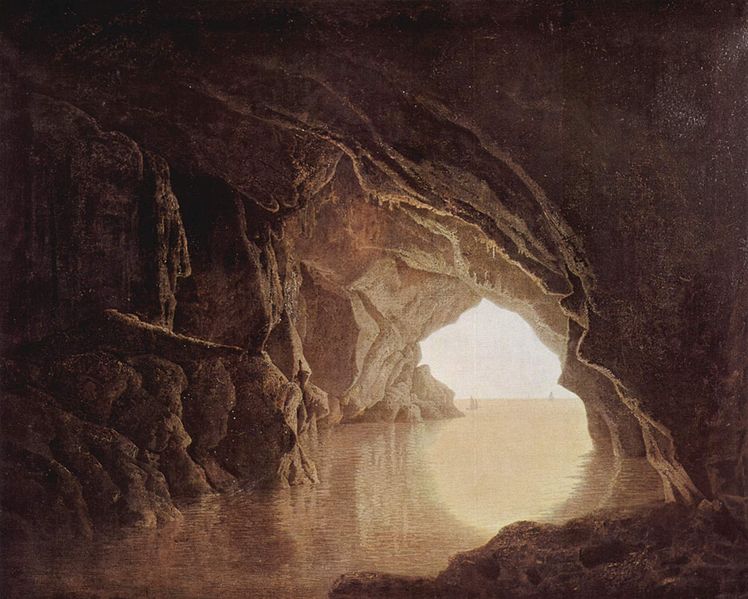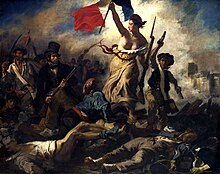 Goya Third of May 1808
Goya Third of May 1808
Turner- Flint Castle
Romanticism might best be described as anticlassicism. A reaction against Neoclassicism, it is a deeply-felt style which is individualistic, exotic, beautiful and emotionally wrought.
Although Romanticism and Neoclassicism were philosophically opposed, they were the dominant European styles for generations, and many artists were affected to a lesser or greater degree by both. Artists might work in both styles at different times or even combine elements, creating an intellectually Romantic work using a Neoclassical visual style, for example.
Great artists closely associated with Romanticism include Caspar David Friedrich, John Constable, J.M.W. Turner and William Blake.
In the North America, the leading Romantic movement was the Hudson River School of dramatic landscape painting.
Obvious successors of Romanticism include the Pre-Raphaelite movement and the Symbolist painters. But Impressionism, and through it almost all of 20th century art, is also firmly rooted in the individualism of the Romantic tradition.
 Wright- Cave At Evening
Wright- Cave At Evening
In a basic sense, the term "Romanticism" has been used to refer to certain artists, poets, writers, musicians, as well as political, philosophical and social thinkers of the late 18th and early to mid 19th centuries. It has equally been used to refer to various artistic, intellectual, and social trends of that era. Despite this general usage of the term, a precise characterization and specific definition of Romanticism have been the subject of debate in the fields of intellectual history and literary history throughout the 20th century, without any great measure of consensus emerging.
Arthur Lovejoy attempted to demonstrate the difficulty of defining Romanticism in his seminal article "On The Discrimination of Romanticisms" in his Essays in the History of Ideas (1948); some scholars see romanticism as essentially continuous with the present, some like Robert Hughes see in it the inaugural moment of modernity, [7] some like Chateaubriand, 'Novalis' and Samuel Taylor Coleridge see it as the beginning of a tradition of resistance to Enlightenment rationalism—a 'Counter-Enlightenment'— [8] [9] to be associated most closely with German Romanticism. Still others place it firmly in the direct aftermath of the French Revolution.[citation needed] An earlier definition comes from Charles Baudelaire: "Romanticism is precisely situated neither in choice of subject nor exact truth, but in the way of feeling."[10]
"Counter-Enlightenment"
Many intellectual historians have seen Romanticism as a key movement in the Counter-Enlightenment, a reaction against the Age of Enlightenment. Whereas the thinkers of the Enlightenment emphasized the primacy of reason, Romanticism emphasized intuition, imagination, and feeling, to a point that has led to some Romantic thinkers being accused of irrationalism[citation needed].
Romanticism focuses on Nature: a place free from society's judgement and restrictions. Romanticism blossomed after the age of Rationalism, a time that focused on handwork and scientific reasoning.
Genius, originality, authorship
The Romantic movement developed the idea of the absolute originality and artistic inspiration by the individual genius, which performs a "creation from nothingness;" this is the so-called Romantic ideology of literary authorship, which created the notion of plagiarism and the guilt of a derivativeness.[11][12][13][14] This idea is often called "romantic originality."[15][16][17] The romantic poets' turned their beliefs on originality into "the institution of originality."[18][19] The English poet John Milton, which lived in the 17 century, was part of the origin of the concept.[20]
This idea was in contrast with the preceding artistic tradition, in which copying has been seen a fundamental practice of the creative process; and has been especially challenged since the beginning of the 20th century, with the boom of the modernist and postmodern movements.[14][21][22]
In European painting, led by a new generation of the French school,[31] the Romantic sensibility contrasted with the neoclassicism being taught in the academies. In a revived clash between color and design, the expressiveness and mood of color, as in works of J.M.W. Turner, Francisco Goya, Théodore Géricault and Eugène Delacroix, emphasized in the new prominence of the brushstroke and impasto the artist's free handling of paint, which tended to be repressed in neoclassicism under a self-effacing finish.
As in England with J.M.W. Turner and Samuel Palmer, Russia with Orest Kiprensky, Ivan Aivazovsky and Vasily Tropinin, Germany with Caspar David Friedrich, Norway with J.C. Dahl and Hans Gude, Spain with Francisco Goya, and France with Théodore Géricault, Eugène Delacroix, Théodore Chassériau, and others; literary Romanticism had its counterpart in the American visual arts, most especially in the exaltation of an untamed American landscape found in the paintings of the Hudson River School. Painters like Thomas Cole, Albert Bierstadt and Frederic Edwin Church and others often expressed Romantic themes in their paintings. They sometimes depicted ancient ruins of the old world, such as in Fredric Edwin Church’s piece Sunrise in Syria. These works reflected the Gothic feelings of death and decay. They also show the Romantic ideal that Nature is powerful and will eventually overcome the transient creations of men. More often, they worked to distinguish themselves from their European counterparts by depicting uniquely American scenes and landscapes. This idea of an American identity in the art world is reflected in W. C. Bryant’s poem, To Cole, the Painter, Departing for Europe, where Bryant encourages Cole to remember the powerful scenes that can only be found in America. This poem also shows the tight connection that existed between the literary and visual artists of the Romantic Era.[citation needed]
Some American paintings promote the literary idea of the “noble savage” (Such as Albert Bierstadt’s The Rocky Mountains, Lander's Peak) by portraying idealized Native Americans living in harmony with the natural world.
Thomas Cole's paintings feature strong narratives as in The Voyage of Life series painted in the early 1840s that depict man trying to survive amidst an awesome and immense nature, from the cradle to the grave.
To insulate theology from reductionism in science, 19th century post-Enlightenment German theologians moved in a new direction, led by Friedrich Schleiermacher and Albrecht Ritschl. They took the Romantic approach of rooting religion in the inner world of the human spirit, so that it is a person's feeling or sensibility about spiritual matters that comprises religion.[32]






